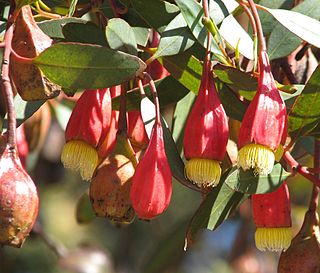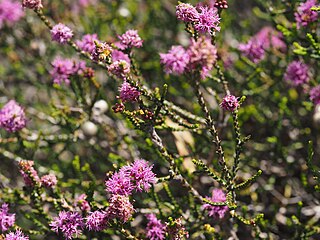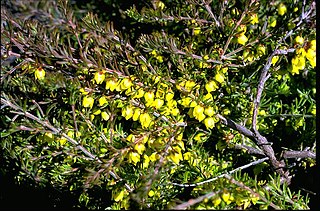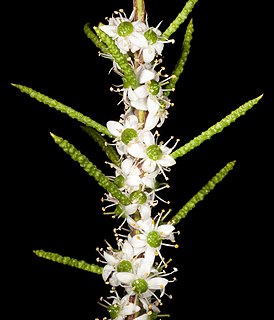
Eucalyptus eremophila, commonly known as the sand mallet or tall sand mallee, is a species of mallet that is endemic to semi-arid regions of Western Australia. It has smooth pale brown and greyish bark, narrow lance-shaped to elliptical adult leaves, flower buds arranged in groups of between seven and eleven with an elongated operculum, and cup-shaped to barrel-shaped fruit.

Banksia purdieana is a species of bushy shrub that is endemic to Western Australia. It has broadly linear, pinnatipartite leaves with sharply-pointed lobes on the sides, yellow flowers in heads of about eighty and egg-shaped follicles.

Eucalyptus forrestiana, commonly known as fuchsia gum or fuchsia mallee, is a species of small tree or mallet and is endemic to an area near Esperance, Western Australia. It has smooth grey bark, narrow oblong to lance-shaped adult leaves, flower buds that are square in cross-section, red at maturity and arranged singly in leaf axils, yellow flowers and four-angled, winged fruit.

Eremophila dichroantha, also known as bale-hook eremophila, is a flowering plant in the figwort family, Scrophulariaceae and is endemic to the south-west of Western Australia. It is a shrub with many ascending branches making the plant appear broom-like. It has small, hooked leaves and small, though abundant, violet to lilac-coloured flowers.

Melaleuca cliffortioides is a plant in the myrtle family, Myrtaceae and is endemic to the south-west of Western Australia. It is a small, prickly shrub very similar to Melaleuca podiocarpa but with fewer stamens in the flowers.

Melaleuca depressa is a plant in the myrtle family, Myrtaceae and is endemic to the south-west of Western Australia. It is a small, bushy shrub with clusters of yellow or cream flowers on the ends of its branches in spring.

Melaleuca psammophila is a plant in the myrtle family, Myrtaceae, and is endemic to the south-west of Western Australia. It is a small shrub with narrow leaves, heads of purple, pink or mauve flowers and clusters of woody fruit. It is similar to M. bisulcata but differs from that species in characters such as the shape of its fruit, leaves and buds but like that species is an attractive, profusely flowering shrub suitable for cultivation as a garden plant.

Melaleuca sclerophylla is a plant in the myrtle family, Myrtaceae, and is endemic to the south-west of Western Australia. It is distinguished by its unusual leaves which are rough, leathery and covered with small, warty lumps and by its many purple heads of flowers in early spring.

Regelia cymbifolia is a plant in the myrtle family, Myrtaceae and is endemic to the south-west of Western Australia. It is a much branched shrub bearing tiny, wedge shaped leaves and clusters of deep pink to purple flowers on the ends of its branches in spring.

Isopogon alcicornis, commonly known as the elkhorn coneflower, is a plant in the family Proteaceae and is endemic to part of the south coast of Western Australia. It is a low shrub with pinnately-lobed leaves and oval heads of hairy, white or pink flowers.

Eremophila calorhabdos, commonly known as red rod or spiked eremophila, is a flowering plant in the figwort family, Scrophulariaceae and is endemic to the south-west of Western Australia. It is a distinctive shrub with erect, rod-like branches up to 2.5 m (8 ft) high, leaves with small teeth along the edges, and flowers that change from orange to lipstick pink as they open.

Eremophila georgei is a flowering plant in the figwort family, Scrophulariaceae and is endemic to Western Australia. It is a common, widespread shrub in central areas of the state, often growing on rocky ridges and hillsides and has serrated leaves and mauve, purple or pink flowers.

Eremophila ionantha is a flowering plant in the figwort family, Scrophulariaceae and is endemic to Western Australia. It is a shrub with many sticky branches, narrow, light green leaves and blue, purple or violet flowers.
Verticordia muelleriana is a flowering plant in the myrtle family, Myrtaceae and is endemic to the south-west of Western Australia. It is an openly branched shrub with relatively large, egg-shaped to circular leaves and long spikes of deep maroon coloured flowers in spring and early summer.
Baeckea grandis is a shrub found in central Western Australia.
Conothamnus neglectus is a member of the family Myrtaceae endemic to Western Australia. This open shrub typically grows to a height of 0.2 to 1.0 metre. It blooms in between July and September producing yellow flowers.
Conospermum eatoniae, commonly known as blue lace, is a shrub endemic to Western Australia.

Boronia purdieana is a plant in the citrus family, Rutaceae and is endemic to the south-west of Western Australia. It is a shrub with pinnate leaves and yellow, four-petalled flowers arranged singly in leaf axils.

Philotheca deserti is a species of flowering plant in the family Rutaceae and is endemic to inland Western Australia. It is an erect shrub with narrow spindle-shaped, glandular-warty leaves and white flowers arranged singly in leaf axils.

Philotheca tomentella is a species of flowering plant in the family Rutaceae and is endemic to the south-west of Western Australia. It is an undershrub with small club-shaped to cylindrical leaves and white flowers with a pale red central stripe, arranged singly or in groups of up to four on the ends of branchlets.















